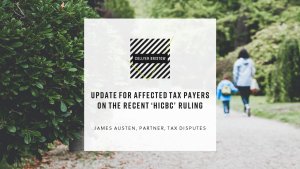- Tax disputes & investigations

Longer Reads
Corporate residence of subsidiaries: Court of Appeal decision provides more questions than answers
In the recent case of HMRC v Development Securities, the Court of Appeal (CA) considered the tax residence of three Jersey-incorporated subsidiaries of a UK company. Overturning the decision of the Upper Tribunal (UT), the CA reinstated the decision of the First-Tier Tribunal (FTT) that the three subsidiaries were resident in England, resulting in the defeat of the company group’s tax planning arrangements.
4 minute read
Published 11 March 2021
Key information
- Services
- Tax disputes & investigations
Though the CA judges unanimously agreed that the UT’s reasons for overturning the FTT decision were flawed, the judges disagreed on whether the FTT decision might have been wrong for other reasons – an issue that was strictly out of the scope of the CA appeal, but which is clearly relevant to future cases.
This is the first time that the CA has considered corporate residence since the seminal case of Wood v Holden[2] in 2006, and it has left unhelpful ambiguity in the law on this issue.
Nevertheless, the case points to some helpful steps that non-UK directors can take to make it less likely that the non-UK residence of subsidiary companies will be challenged by HMRC.
Background
Following tax planning advice, Development Securities plc (DS plc) set up three subsidiary companies in Jersey for the discrete purpose of acquiring certain assets for more than their market value. This was in order to use the latent losses that the company group had incurred on these assets to offset gains achieved elsewhere in the company group. DS plc accepted that a tax avoidance scheme was being implemented by these arrangements.
For the tax planning to work, it was vital that the three subsidiaries were not resident in the UK (and, in this case, were instead resident in Jersey) for corporate tax purposes at the point that the subsidiaries acquired the assets at an overvalue. HMRC challenged this aspect of the planning.
The law on corporate residence
To determine the residence of a company for tax purposes, you must ask: where does the company’s “real business” – or its “central management and control” (CMC) – take place[3]? This is a question of fact in each case.
In company groups, it is entirely usual for the directors of subsidiary companies to know what the parent company wants them to do, and to take those wishes into account when making their decisions. This is particularly the case for special purpose vehicles (SPVs), who may have been formed by the parent company to undertake a specific task. However, this will not itself ordinarily change the tax residence of the subsidiaries – so long as it is the subsidiaries themselves who are actually taking the relevant decisions, and not the parent.
Where is this line drawn? The CA stated in Wood v Holden that a parent could ‘propose, advise and influence’ the decisions of subsidiaries, but not ‘dictate’ them. If a parent ‘usurps’ the functions of the subsidiary’s board of directors, or if the subsidiary’s board of directors ‘stands aside’ from decisions or signs documents ‘mindlessly’, this may shift the tax residence of the subsidiary to that of its parent.
The FTT Decision
The FTT scrutinised in detail the board minutes and other relevant documents relating to the subsidiaries’ directors’ approval of the acquisition of the assets at an overvalue.
The FTT concluded that the directors were not “actively engaging” with the “substantive” / “strategic” decision of whether or not the subsidiaries should approve the acquisition. Instead, the directors simply acted on the basis of what they understood to be an instruction from DS plc to approve the acquisition and concerned themselves only with whether the acquisition was legal. As such, the CMC of the subsidiaries was being exercised by DS plc in England, and not by the directors of the subsidiaries in Jersey. DS plc had in practice “usurped” the functions of the boards of directors of the subsidiaries.
The UT Decision
The UT did not consider the FTT’s decision to be correct as a matter of fact or law, and therefore overturned it, finding instead that “the Jersey directors did properly consider the decisions they made on behalf of the Jersey Companies and that, in consequence, CMC was exercised in Jersey“. It should be said that for the UT to overturn a carefully reached factual decision of the FTT in this way is rare and unusual.
The CA Decision
The CA judges were unanimous in finding that the UT had mischaracterised the basis of the FTT decision and that the UT’s decision was therefore flawed. For a procedural reason, the CA was not required to then consider whether the FTT decision might have been wrong for other reasons. The CA therefore overturned the UT decision, reinstating the FTT’s decision that the three subsidiaries were tax resident in England.
Despite not being required to rule on the issue, two of the judges chose to express their own views on the FTT’s decision, with the third judge choosing to stay silent. Sadly, the two stated views conflicted:
- In Lord Justice Nugee’s view, the FTT had departed significantly from previous case law:a) He agreed with DS plc’s counsel’s observation that “the FTT’s decision was the first time in any case where the local board of directors of a company had actually met, had understood what they were being asked to do, had understood why they were being asked to do it, had decided it was lawful, had reviewed for itself the transactional documents, had been found not to have acted mindlessly, but had nevertheless been found not to have exercised CMC”;b) The relevant question is not whether the directors ‘actively engaged’ with the ‘strategic decision’ in the sense of considering whether the acquisition was a good plan for the three subsidiaries. “The question is a much simpler one, namely: did they make the decision?” Even if the directors did not consider the merits and demerits of the acquisition for the subsidiaries, acting instead on the basis of an instruction from the parent company, this simply describes how and why the decision was made. It does not mean that the directors did not make the decision.
- Lord Justice David Richards, on the other hand, did not have any concerns with the FTT’s reasoning. If the directors were simply acting on the basis of an instruction from the parent company, then the decision was made by DS plc in England, not by the subsidiaries in Jersey.
The disagreement between the judges leaves an unfortunate lack of clarity in the law. To exercise CMC, does a subsidiary company have to ‘actively engage’ with the merits of a parent’s proposal and make a ‘substantive decision’ on the matter, or can it simply take the decision to implement the proposal of a parent company?
What can we learn?
The case shows the importance of properly evidencing the board decisions of non-UK subsidiaries through board minutes and other documents, as these may be subject to detailed scrutiny by HMRC and by the courts. Long experience of CMC enquiries shows us that HMRC will seek to examine all relevant (and many irrelevant) records in minute detail.
These documents should record the rationale for the decisions made. Whilst the current uncertainty in the law remains, it will be best to ensure that the documents also record an engagement by the directors with the potential merits and demerits of the decision for the subsidiary itself, and make clear that the subsidiary company has considered these matters from its own perspective, rather than just relying on the parent company’s assessment. These minutes should not be drafted for the board in advance by their advisors.
This is likely to be particularly important in cases (such as this) where the proposal lacks any real commercial benefit for the subsidiary company itself. Such cases may especially attract HMRC’s attention, especially where a tax avoidance motive is evident, and the lack of any commercial benefit to the subsidiaries formed a significant theme in the FTT’s decision in this case. Nevertheless, as long as the reasons for the subsidiary’s decision are properly recorded, this factor should not impact the subsidiary’s tax residence.
Stepping back, the CA decision in Development Securities does little to advance the state of the law beyond that set out in Wood v Holden. But it is a timely reminder that CMC is very much on HMRC’s radar (something the global Covid-19 pandemic will have done nothing to change) and that careful and meticulous attention to CMC matters is an absolute pre-requisite whenever tax residence is in point. CMC enquiries can be expensive – and burdensome – to manage, and they are best avoided in the first place!
[1] [2020] EWCA Civ 1705
[1] [2006] EWCA Civ 26
[1] De Beers Consolidated Mines Ltd v Howe [1906] AC 455
Longer Reads
Corporate residence of subsidiaries: Court of Appeal decision provides more questions than answers
In the recent case of HMRC v Development Securities, the Court of Appeal (CA) considered the tax residence of three Jersey-incorporated subsidiaries of a UK company. Overturning the decision of the Upper Tribunal (UT), the CA reinstated the decision of the First-Tier Tribunal (FTT) that the three subsidiaries were resident in England, resulting in the defeat of the company group’s tax planning arrangements.
Published 11 March 2021
Associated sectors / services
Though the CA judges unanimously agreed that the UT’s reasons for overturning the FTT decision were flawed, the judges disagreed on whether the FTT decision might have been wrong for other reasons – an issue that was strictly out of the scope of the CA appeal, but which is clearly relevant to future cases.
This is the first time that the CA has considered corporate residence since the seminal case of Wood v Holden[2] in 2006, and it has left unhelpful ambiguity in the law on this issue.
Nevertheless, the case points to some helpful steps that non-UK directors can take to make it less likely that the non-UK residence of subsidiary companies will be challenged by HMRC.
Background
Following tax planning advice, Development Securities plc (DS plc) set up three subsidiary companies in Jersey for the discrete purpose of acquiring certain assets for more than their market value. This was in order to use the latent losses that the company group had incurred on these assets to offset gains achieved elsewhere in the company group. DS plc accepted that a tax avoidance scheme was being implemented by these arrangements.
For the tax planning to work, it was vital that the three subsidiaries were not resident in the UK (and, in this case, were instead resident in Jersey) for corporate tax purposes at the point that the subsidiaries acquired the assets at an overvalue. HMRC challenged this aspect of the planning.
The law on corporate residence
To determine the residence of a company for tax purposes, you must ask: where does the company’s “real business” – or its “central management and control” (CMC) – take place[3]? This is a question of fact in each case.
In company groups, it is entirely usual for the directors of subsidiary companies to know what the parent company wants them to do, and to take those wishes into account when making their decisions. This is particularly the case for special purpose vehicles (SPVs), who may have been formed by the parent company to undertake a specific task. However, this will not itself ordinarily change the tax residence of the subsidiaries – so long as it is the subsidiaries themselves who are actually taking the relevant decisions, and not the parent.
Where is this line drawn? The CA stated in Wood v Holden that a parent could ‘propose, advise and influence’ the decisions of subsidiaries, but not ‘dictate’ them. If a parent ‘usurps’ the functions of the subsidiary’s board of directors, or if the subsidiary’s board of directors ‘stands aside’ from decisions or signs documents ‘mindlessly’, this may shift the tax residence of the subsidiary to that of its parent.
The FTT Decision
The FTT scrutinised in detail the board minutes and other relevant documents relating to the subsidiaries’ directors’ approval of the acquisition of the assets at an overvalue.
The FTT concluded that the directors were not “actively engaging” with the “substantive” / “strategic” decision of whether or not the subsidiaries should approve the acquisition. Instead, the directors simply acted on the basis of what they understood to be an instruction from DS plc to approve the acquisition and concerned themselves only with whether the acquisition was legal. As such, the CMC of the subsidiaries was being exercised by DS plc in England, and not by the directors of the subsidiaries in Jersey. DS plc had in practice “usurped” the functions of the boards of directors of the subsidiaries.
The UT Decision
The UT did not consider the FTT’s decision to be correct as a matter of fact or law, and therefore overturned it, finding instead that “the Jersey directors did properly consider the decisions they made on behalf of the Jersey Companies and that, in consequence, CMC was exercised in Jersey“. It should be said that for the UT to overturn a carefully reached factual decision of the FTT in this way is rare and unusual.
The CA Decision
The CA judges were unanimous in finding that the UT had mischaracterised the basis of the FTT decision and that the UT’s decision was therefore flawed. For a procedural reason, the CA was not required to then consider whether the FTT decision might have been wrong for other reasons. The CA therefore overturned the UT decision, reinstating the FTT’s decision that the three subsidiaries were tax resident in England.
Despite not being required to rule on the issue, two of the judges chose to express their own views on the FTT’s decision, with the third judge choosing to stay silent. Sadly, the two stated views conflicted:
- In Lord Justice Nugee’s view, the FTT had departed significantly from previous case law:a) He agreed with DS plc’s counsel’s observation that “the FTT’s decision was the first time in any case where the local board of directors of a company had actually met, had understood what they were being asked to do, had understood why they were being asked to do it, had decided it was lawful, had reviewed for itself the transactional documents, had been found not to have acted mindlessly, but had nevertheless been found not to have exercised CMC”;b) The relevant question is not whether the directors ‘actively engaged’ with the ‘strategic decision’ in the sense of considering whether the acquisition was a good plan for the three subsidiaries. “The question is a much simpler one, namely: did they make the decision?” Even if the directors did not consider the merits and demerits of the acquisition for the subsidiaries, acting instead on the basis of an instruction from the parent company, this simply describes how and why the decision was made. It does not mean that the directors did not make the decision.
- Lord Justice David Richards, on the other hand, did not have any concerns with the FTT’s reasoning. If the directors were simply acting on the basis of an instruction from the parent company, then the decision was made by DS plc in England, not by the subsidiaries in Jersey.
The disagreement between the judges leaves an unfortunate lack of clarity in the law. To exercise CMC, does a subsidiary company have to ‘actively engage’ with the merits of a parent’s proposal and make a ‘substantive decision’ on the matter, or can it simply take the decision to implement the proposal of a parent company?
What can we learn?
The case shows the importance of properly evidencing the board decisions of non-UK subsidiaries through board minutes and other documents, as these may be subject to detailed scrutiny by HMRC and by the courts. Long experience of CMC enquiries shows us that HMRC will seek to examine all relevant (and many irrelevant) records in minute detail.
These documents should record the rationale for the decisions made. Whilst the current uncertainty in the law remains, it will be best to ensure that the documents also record an engagement by the directors with the potential merits and demerits of the decision for the subsidiary itself, and make clear that the subsidiary company has considered these matters from its own perspective, rather than just relying on the parent company’s assessment. These minutes should not be drafted for the board in advance by their advisors.
This is likely to be particularly important in cases (such as this) where the proposal lacks any real commercial benefit for the subsidiary company itself. Such cases may especially attract HMRC’s attention, especially where a tax avoidance motive is evident, and the lack of any commercial benefit to the subsidiaries formed a significant theme in the FTT’s decision in this case. Nevertheless, as long as the reasons for the subsidiary’s decision are properly recorded, this factor should not impact the subsidiary’s tax residence.
Stepping back, the CA decision in Development Securities does little to advance the state of the law beyond that set out in Wood v Holden. But it is a timely reminder that CMC is very much on HMRC’s radar (something the global Covid-19 pandemic will have done nothing to change) and that careful and meticulous attention to CMC matters is an absolute pre-requisite whenever tax residence is in point. CMC enquiries can be expensive – and burdensome – to manage, and they are best avoided in the first place!
[1] [2020] EWCA Civ 1705
[1] [2006] EWCA Civ 26
[1] De Beers Consolidated Mines Ltd v Howe [1906] AC 455
Associated sectors / services
- Tax disputes & investigations
Need some more information? Make an enquiry below.
Enjoy reading our articles? why not subscribe to notifications so you’ll never miss one?
Subscribe to our articlesMessage us on WhatsApp (calling not available)
Please note that Collyer Bristow provides this service during office hours for general information and enquiries only and that no legal or other professional advice will be provided over the WhatsApp platform. Please also note that if you choose to use this platform your personal data is likely to be processed outside the UK and EEA, including in the US. Appropriate legal or other professional opinion should be taken before taking or omitting to take any action in respect of any specific problem. Collyer Bristow LLP accepts no liability for any loss or damage which may arise from reliance on information provided. All information will be deleted immediately upon completion of a conversation.
Close








































